Menu

Did you know the United States Department of Agriculture (USDA) has helped American farmers since 1862? It’s a key supporter of American farming. The USDA provides many funding opportunities for agricultural research and development. This aid allows groups like the Foundation for Food and Agriculture Research (FFAR) to make big steps in agriculture.
The FFAR’s work focuses on improving Agroecosystems, Food Systems, and Production Systems. They look for new ways to make farming more sustainable and produce healthier food. This work is not just helpful for farmers. It also keeps the U.S. ahead in worldwide farming. The FFAR has helped through its grants. It has benefited a lot, thanks to support from top farmers and several university experts.
Getting money for research is key in boosting farming methods. This helps the agriculture sector stay strong and grow. Agricultural science grants are vital. They spark new ideas, make farming better, and tackle food security globally.
Agricultural science grants are a big help for those looking to advance farming. This money supports the creation of better, more eco-friendly farming ways. It also makes our food supply safer and boosts how well farms work.
These grants are crucial for handling issues like the changing climate and managing pests. They help in using resources smarter and keep our farm systems healthy.
The Foundation for Food and Agriculture Research (FFAR) hears from leaders in farming. They share stories about how grants help find new ways to stay ahead in farming in the US and the world.
Many research funding agriculture sector options are out there, meeting different innovation needs. The NIFA provides these via competitive grants and state funds. For application details and deadlines, check NIFA’s website.
NIFA’s grant process has phases like Pre-Award, Award, and Post-Award. In the Award phase, top applications get fund recommendations. Applicants then set up an ASAP account to get funds quickly.
One major grant, the AFRI, has been funded broadly. It deals with renewable energy, food safety, and biotech, and much more. NIFA’s other grants like CAP and FASE aid big, multi-institutional projects and growth programmes.
With funding for agricultural innovation, groups like research institutions and universities can push through in vital areas. Each grant’s rules are clear in NIFA’s Requests for Applications. This makes the selection process fair and clear.
There are many kinds of agricultural research grants. These include government, private, and non-profit grants. There are also funds specifically for sustainable farming. Researchers and farmers can use these to make progress in different areas of agriculture.
Government grants for agriculture research are very important. The USDA runs many programs to help. Notable ones include the 1890 Facilities Grants Program for educational institutions. There’s also the Biotechnology Risk Assessment Research Grants Program for studying genetic risks. Other programs like the Food Safety Outreach Program and AgrAbility help with farm safety and tech for disabled farmers.
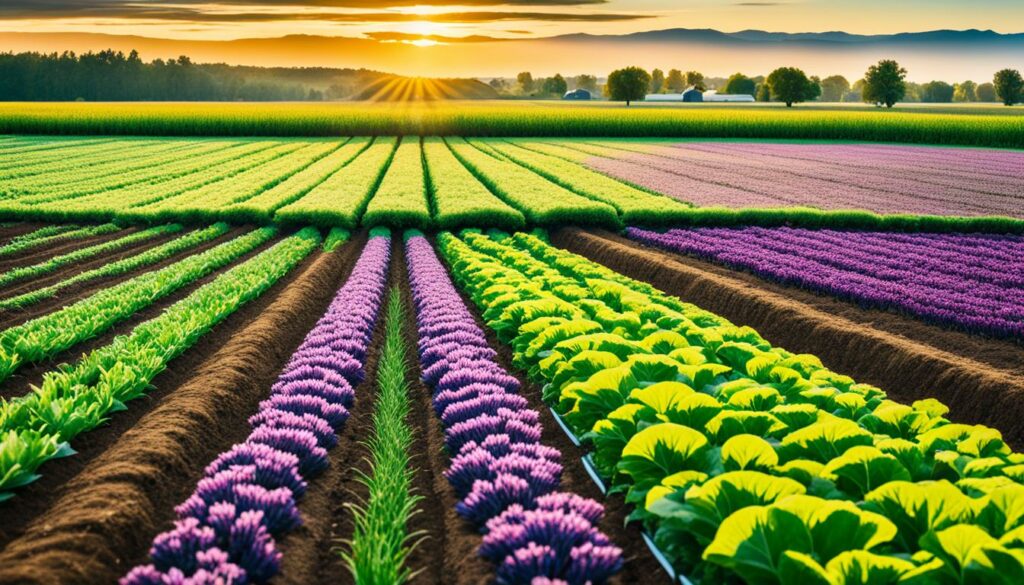
Private and non-profit grants are crucial too. The Foundation for Food and Agriculture Research (FFAR) is a leader here. They support a wide range of projects, from robot farming to new education models. Their grants often aim to improve sustainability and farming methods.
Funding for sustainable agriculture is vital for the planet. The Southern SARE Program, launched in 1988, focuses on this. They require at least three farmers to work together in each project. Each project can get up to $400,000 over three years. They also offer support for safer and greener farming through programs like the Biotechnology Risk Assessment Research Grants Program.
| Programme | Focus | Funding Limit |
|---|---|---|
| Southern SARE’s Research and Education Grants | Sustainable Agriculture, Community Involvement | $400,000 |
| Biotechnology Risk Assessment Research Grants | Biotechnology, Environmental Risks | Varies |
| Food Safety Outreach Program | Food Safety, Public Health | Varies |
The USDA provides support across the agricultural sector. It helps everyone from small farmers to rural homeowners. Their financial programs aim to boost research and development in farming.
Family-size farmers and ranchers can get USDA funding if they can’t get credit from regular lenders. USDA’s Farm Service Agency (FSA) provides loans for buying farms or for operations. The USDA also works with rural areas, helping with housing and community projects.
The Risk Management Agency (RMA) looks after risk for farmers. They run the Federal Crop Insurance Corporation (FCIC). By working with private insurers, they help manage the risks farmers face.
The USDA focuses on helping historically underserved farmers like Indigenous people, veterans, and those with low income. They get extra help, like more money towards costs and grants earlier. This helps make farming fair and inclusive.
The Farm Service Agency has loans for new farmers. This helps them start even if they can’t get money from banks. Also, grants and programs from the USDA aim to boost sales of special crops. This helps the underserved part of the farming industry.
The USDA works hard to support all kinds of people in farming. They fund research and address specific needs, making sure everyone has a fair chance.
Getting to grips with how to apply for agricultural research grants is key. It helps to get the money you need for your project. We’ll look at each step to boost your success odds.
Applying for research grants in agriculture has three main parts. You first look for a suitable grant opportunity. Then, make sure you fit the grant’s requirements. Finally, send in your detailed application through Grants.gov.
Start by searching for grants that match your project aims using tools like the NIFA’s search function. Then, double-check that you meet all the criteria. Finally, put together and submit your application before the deadline.

Collecting essential documentation for grant application is a must. You need to have all the necessary forms ready. Register both your project and your organisation on Grants.gov and SAM before applying.
Your forms should include a detailed project plan, how you plan to use the money, and letters of support from others in your field. It’s crucial to be on time with your submission. But, late submissions might be considered in special cases.
Eligibility and documents are important, but so is making a good impression. To craft a successful application, keep these tips in mind:
Always check the FAQ when applying for grants. It can clear up common questions and make the application smoother. Following this approach will increase your chances of success.
The USDA has several funding programs for farmers. These aim to improve agriculture across the USA. They cover many areas like saving the environment, making farming sustainable, adding value to products, using green energy, and managing farm expenses.
The EQIP is key for improving land and managing resources. It offers money and expertise to farmers. They use it to perform actions that benefit the soil, water, plants, animals, and the air on their lands.
The SARE Program supports studies and training for farm innovations. It helps farmers, advisors, and scientists create and use new, sustainable methods. These ways of farming earn more, help the environment, and make farm life better.
Farmers get support from VAPG to make their produce worth more. This programme helps in improving how products are sold and processed. It aims to create new items, find better ways to sell them, and earn more for the farmers.
REAP supports buying eco-friendly energy setups and saving energy on farms. It uses both money gifts and loans. REAP lowers energy bills and supports greener farming.
FSA gives direct and backed loans to expand farming. They help start-ups, purchase land, machines, and manage ongoing costs. These loans are essential for new farmers and those wanting to grow.
The table below presents a comparative overview of these key USDA funding programs:
| Program | Focus Area | Target Beneficiaries | Types of Assistance |
|---|---|---|---|
| EQIP | Conservation Practices | Agricultural Producers | Financial and Technical Assistance |
| SARE Program | Sustainable Agriculture | Farmers, Researchers, Extension Agents | Grants for Research and Education |
| VAPG | Value-Added Products | Agricultural Producers | Grants for Marketing and Processing |
| REAP | Renewable Energy | Rural Small Businesses, Agricultural Producers | Grants and Loans |
| FSA Loans | Farm Operations | Farmers and Ranchers | Direct and Guaranteed Loans |
The USDA’s wide-ranging funding reveals their dedication to farming’s health. These programs support eco-friendly farming, financial growth, and the future of farms in the USA. For farmers, learning about these is crucial as they can help run better and more sustainable operations.
Cost-share programs help farmers practice sustainable agriculture. They offer money incentives to help with the costs of good farming projects.
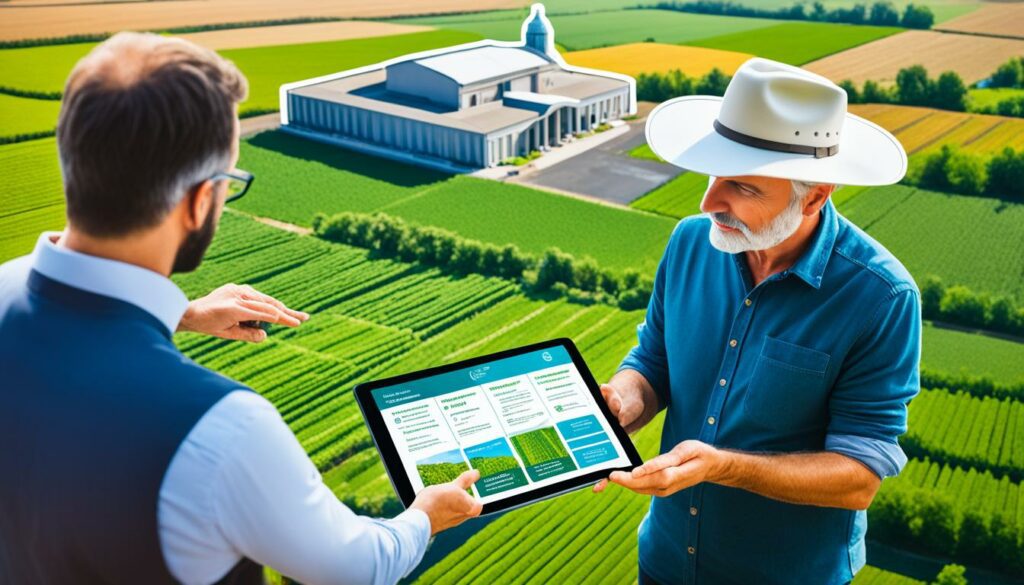
The Environmental Quality Incentives Program (EQIP) is an example. It aids conservation practices by paying for some costs. This makes it cheaper for farmers to go green. The USDA’s Risk Management Agency (RMA) also helps keep farmers economically strong through risk management solutions.
Eligibility for these programs depends on rules set by the USDA. For example, farmers who can’t get regular loans and those in need may get help. This eases their money worries.
Cost-share programs benefit farmers greatly. They make farm upgrades less of a financial strain. They also push for earth-friendly farming. The USDA’s Organic Certification Cost Share Program helps with certification fees for organic farmers. It’s all about making farming life better for more people.
| Program | Description | Grant Amounts |
|---|---|---|
| EQIP | Supports conservation practices by sharing implementation costs with producers. | $2,500 to $1 million |
| SCBGP | Enhances the competitiveness of specialty crops. | No matching funds required; accepted until May 2, 2024 |
| FMPP | Promotes and expands domestic farmers markets and direct market opportunities. | $50,000 to $500,000 with a 25% match requirement |
| SARE | Funds sustainable agriculture projects. | Up to $25,000 or $29,000 for collaborative projects |
Looking into cost-share programmes shows their big impact on farming. They make sustainability doable and possible, especially for those in great need. Knowing how to take part in these programmes and what they offer opens the door to many farming opportunities.
It’s key to understand easements in agricultural funding talks. Easements are formal deals where landowners get paid to keep their land useful for farming or safe for the environment. This helps keep land available for farming or nature, which is good for everyone.
Easements mean limiting how land is used to help keep it good for farming or nature long-term. The ACEP helps with this, combining past efforts to protect lands like wetlands, grasslands, and farms. There are mainly two types under ACEP: WRE for wetlands and ALE for farmlands.
Wetland Reserve Easements (WRE): They focus on making farmlands’ wetlands better, protecting and improving them. These deals can last forever or up to 30 years. Those with permanent agreements can get 75%-100% of their costs covered to manage the wetlands.
Agricultural Land Easements (ALE): ALE easements aim to keep lands for farming. They can last forever or up to the longest time allowed by law. Under ALE, groups that qualify can receive up to half of the easement’s land value. This helps keep farmable land preserved.
Knowing about different easements helps to pick the right one for conservation or farming needs. Let’s look into it in detail:
| Easement Type | Duration | Compensation | Eligibility |
|---|---|---|---|
| Wetland Reserve Easements (WRE) | Permanent or up to 30 years | 75%-100% of WRPO costs | Land must have wetland characteristics or be affected by flooding |
| Agricultural Land Easements (ALE) | Perpetuity or state law maximum | Up to 50% of land value | Entities must manage and enforce easements |
Both conservation easements and agricultural easements face stiff competition. They’re rated against set standards by the NRCS. This ensures that only the best projects that will really help the land get funded.
The IRA has set aside $1.4 billion for ACEP over the next five years. This money is for new easements that protect against climate change and are good for the land. The goal is to make it easier to apply, have the funding available for longer, and to be able to protect more areas. This aims to get more people involved and to really improve farming and conservation.
The USDA offers many emergency and disaster relief grants to aid farmers and farm businesses. These grants are for times when extreme weather hits or when other unexpected events happen. Knowing how to apply and who is eligible is key to getting this support.
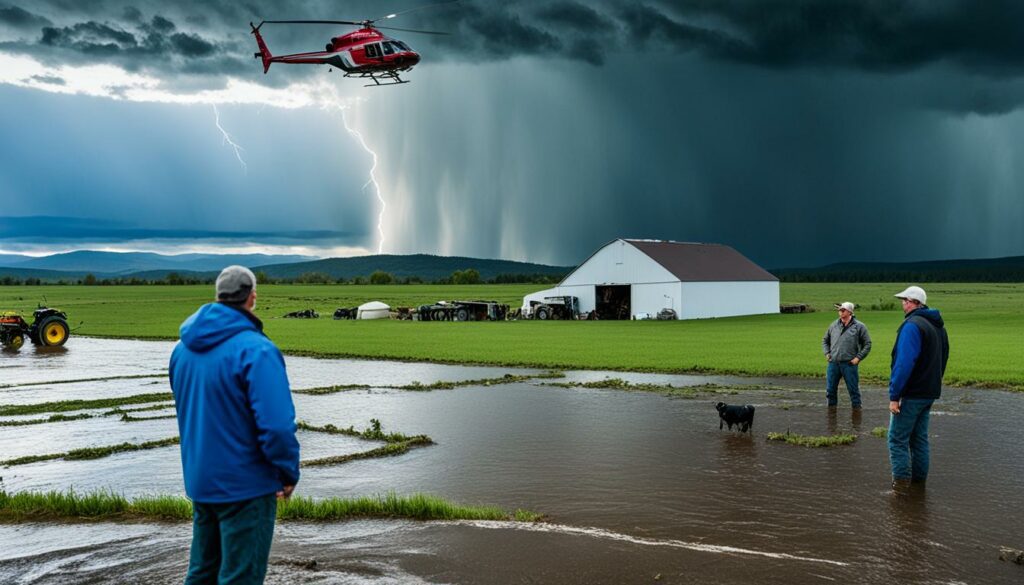
Farmers hit hard by natural disasters must understand emergency relief. The USDA gives around $500 billion yearly through more than 1,000 programmes. These help farms recover and find stability. Notable efforts include the Specialty Crop Block Grant Program and the Resilient Food System Infrastructure Program. They make sure various farming sectors get the help they need.
To get emergency and disaster relief grants, applicants must fit the criteria for emergency funding. The USDA needs grants applied for within 45 days of the event, with checks and acceptance ongoing. Areas like Agroecosystem Resilience and Food Safety are in focus. Projects should have clear short-term goals feasible within three months. It’s good to include ways to teach and inform in your proposal.
| Grant Program | Focus Area | Maximum Grant Amount |
|---|---|---|
| Specialty Crop Block Grant Program | Specialty Crops Competitiveness | $300,000 |
| Farm to School Program | Farm to School Efforts | $300,000 |
| Local Food System Infrastructure Grant | Local Food Supply Chains | $300,000 |
USDA grants have real impacts on agricultural producers. They help companies like Sunsweet Growers, Inc. and Bowman & Landes Turkey Farm succeed. These stories show how USDA funding can make a big difference.
Sunsweet Growers, Inc. uses USDA’s Value-Added Producer Grants (VAPG) to grow. They’ve added new products to meet changing customer needs. Now, they have a bigger market share and make more money. These grants help not only with profits but with a company’s future too.
In New Carlisle, Ohio, Bowman & Landes Turkey Farm made a change. With a Rural Energy for America Program (REAP) grant, they built a solar array. This move cut their energy bills and their impact on the environment. Their story shows how USDA grants can help in many ways.
| Grant Programme | Recipient | Achievements |
|---|---|---|
| VAPG | Sunsweet Growers, Inc. | Product diversification, increased market share, enhanced profitability |
| REAP | Bowman & Landes Turkey Farm | Installed solar array, reduced energy costs, environmental sustainability |
These stories point out the good from USDA grants. Places like Sunsweet Growers and Bowman & Landes use them well. They help with making money and being kind to the earth. These grants do a lot for everyone involved.
Many important funding sources are out there for agricultural research. They focus on different parts of farming, such as food safety, animal health, and nature protection.
NIFA helps agricultural progress with its grants. Its main scheme, the AFRI, supports study in areas like plant health, food safety, and economics. Although it hopes to fund the AFRI at $700 million yearly, it currently gives $455 million. NIFA offers various grants to tackle farming’s big challenges.
Improving nutrition and food safety across the U.S. is FNS’s goal. It funds projects on nutrition education and helps provide more food, boosting public health and the food system as a whole.
ARS tackles big agricultural issues for the U.S. It looks into areas like farm efficiency, renewable energy, and nutrition. Its work supports farming progress in a sustainable way.
NRCS supports farmers and ranchers with land and soil improvement. Its key programme, EQIP, promotes better land management. This boosts sustainability in farming.
APHIS keeps the U.S. farm safe from harmful pests and diseases. By protecting crops and animals, it helps the farming industry stay strong.
It’s key for those in agriculture to know and use these funding sources. The help from NIFA, FNS, ARS, NRCS, and APHIS is broad. It gives strong support to tackle many farming challenges.
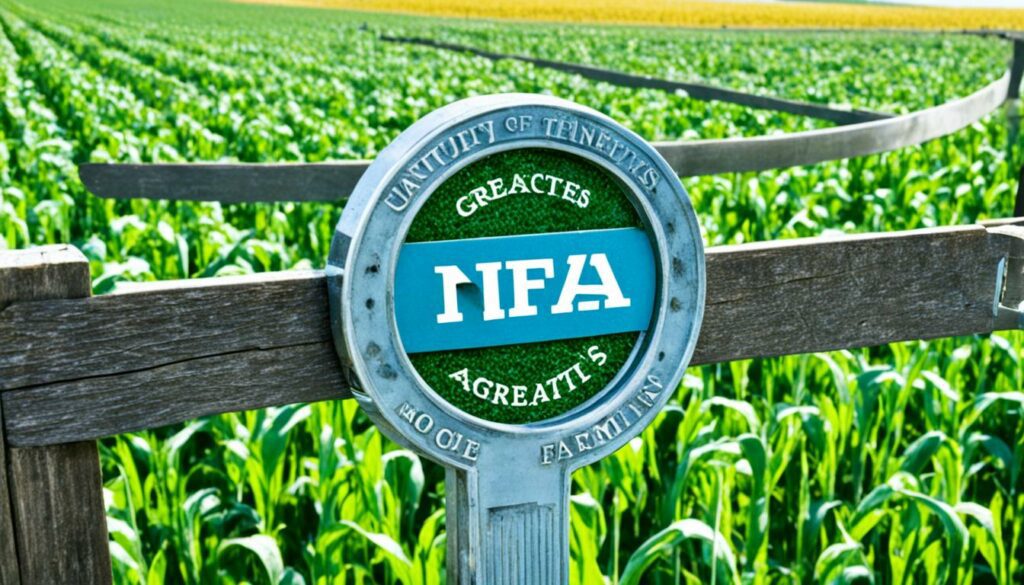
Agricultural research grants are key for many farming types. They help with different challenges and chances. These grants boost crop growth, better animal care, and new farming methods in cities and indoors.
Grants for growing crops are vital. They push forward farming methods, up the harvest, and make sure we have enough food. Programs like the Direct Farm Loans and Microloans help family farms get the land, gear, and stuff they need. The Noninsured Crop Disaster Assistance Program steps in when crops fail, giving extra help to new and low-income farmers.
Taking care of animals well is crucial in farming. Grants for their welfare, like from the Conservation Innovation Grants, help find new and better ways to keep animals. The Whole Farm Revenue Protection sorts out insurance for mixed farms. It covers all their plants and animals. There’s also the Food Safety Outreach Program for farmer training in animal food safety.
Farming in cities and indoors is a big chance for more food. Grants in this area support selling food straight to the buyer. They are backed by the Farmers Market and Local Food Promotion Program. The USDA Rural Development (RD) helps with loans and grants for setting up city and indoor farms. This includes new ways like aquaponics and vertical farming.
| Program | Focus Area | Eligible Farmers |
|---|---|---|
| Beginning Farmer and Rancher Development Program | An array of training projects for beginning farmers | Non-profit organisations, academic institutions, producer groups |
| Direct Farm Loans | Purchasing farmland, equipment, and production necessities | Family farmers, beginning farmers, socially disadvantaged farmers |
| Conservation Innovation Grants | Developing conservation solutions | Farmers, ranchers |
| Farmers Market and Local Food Promotion Program | Direct-to-consumer marketing strategies | Local enterprises |
No matter your farming area, there are grants to help. They boost your work and bring new farm ideas. This aid helps farms become more green, do better, and ensures farming’s future.
The AFRI programme helps start innovative agricultural research projects. It is currently funded at $455 million yearly under the 2023 Consolidated Appropriations Act. These projects, funded by many organisations, aim to improve agriculture and food systems across the nation.
The AFRI supported a big project at the University of Wisconsin with $10 million. This focused on changing how we farm to help the environment. Kansas State University got nearly $10 million to study better ways to grow crops. Also, the University of Idaho grabbed almost half a million to look at eco-friendly farming. These projects help move both basic and practical science forward.
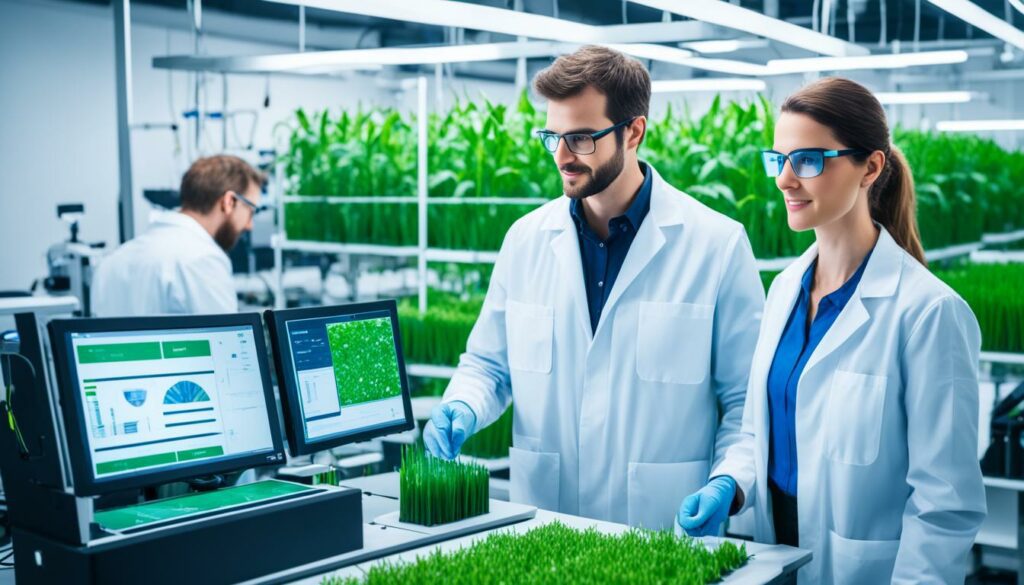
Research backed by AFRI makes a huge impact on farming and food. Projects like CAP and FASE make big changes in fields like climate change and rural life. They also spread important science to everyone. This helps us get ready for feeding 10 billion people by 2050, even with less land and changing weather.
From 2012 to 2018, AFRI’s support has reached over $2 billion. This money goes to big and small projects, all helping to improve farming. These ongoing investments show the vital role of new research in the future of food. They make sure our food systems are sustainable and support farmers.
Getting agricultural research grants is tough work. There are many steps to the application and lots of mistakes to watch out for. It’s vital to know these hurdles. This knowledge boosts the chances of getting a grant and makes the process smoother.
Grants for agricultural research are hard to get through. The application process is full of rules that some find confusing. This is made worse by less money for specific projects, like the Organic Transitions Research Program.
Instead, focus moves to broader programs. For instance, the Agriculture and Food Research Initiative now gets more attention. This switch has been challenging for those in organic farming. Reports show they lack needed support.
Skipping mistakes is key to winning a grant. People often miss sending all required documents. They might also overlook small parts of the application or not match the grant’s goals.
The NORA-22 report has shown struggles in organic farming due to less money. It calls on scientists to apply for more grants. This could help get better support for areas in need.
Here’s how to avoid application errors:
Avoiding common application mistakes boosts research projects’ chances of getting funded. By working carefully, researchers can show funding bodies like NIFA the importance of investing in areas like organic farming. This may lead to more funding for these key sectors.
In the future, the way we fund agricultural research will change a lot. With money moving around and new areas of study, it is key for everyone involved to be aware of these shifts.
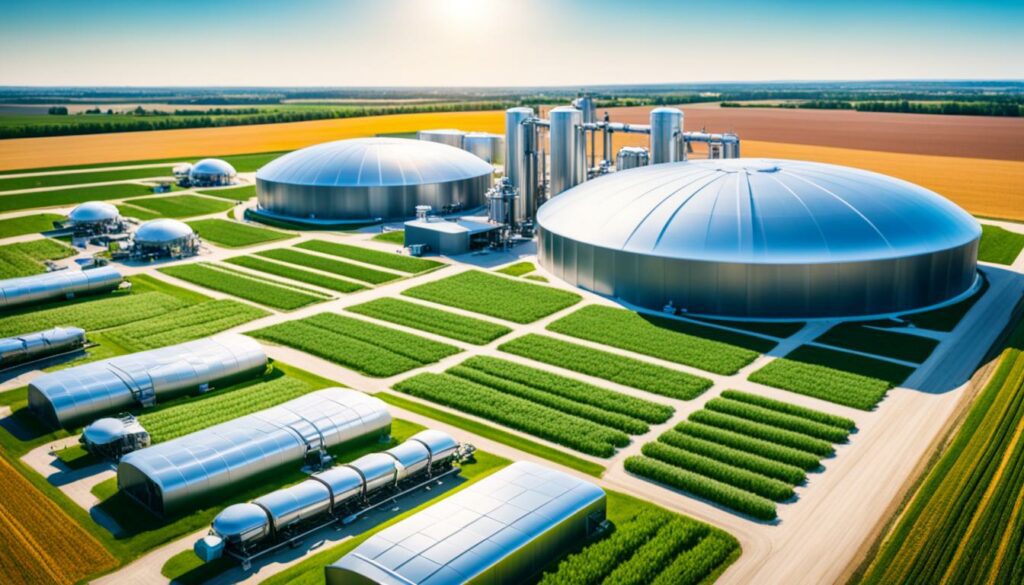
The USDA has upped its research money by 2.5% for 2024, reaching $1.8 billion. This shows the government’s push to support new studies. However, this boost is far less than the drop in public cash for food and farm studies, which is now down by about a third since 2002. This gap underlines the importance of smart money use and creative approaches in funding research.
Due to real decreases, the focus has turned to emerging research areas like biotech, precision farming, and being more green. Since 1980, when accounting for inflation, the money the USDA gives each State has stayed the same. This means new areas rely heavily on specific grants. Even though NIFA’s general budget dropped by 1.7% in 2024, with $60 million they’re boosting some ARS research sites. This help is mainly for building better facilities and grounds, showing a clear infrastructure focus.
Pushing innovation in farming tech is a big priority. But, hurdles in getting money are still there. The Agriculture Advanced Research and Development Authority’s budget was slashed to $500,000. This shows how research funds can change fast. Similarly, competitive grants are facing not-so-good times. While competitive funds grew a lot by the mid-1990s, lately, ARFI’s funds have dropped by nearly $10 million to $445.2 million for 2024.
Looking ahead, it’s vital for the government to find more money for future agricultural studies. This could involve supporting the next farm bill. The farm bill is key to ongoing investments in both farming tech and new study areas.
Agricultural research grants are key to moving farming forward. They help introduce new ideas and keep the earth healthy. Projects like the Sustainable Agriculture Research and Education (SARE) show us the many ways we can get funding. These grants let experts and farmers work together on big projects that change how we do things.
Thanks to groups like SARE, people in farming can learn and try new ways of farming, like using smart plants to avoid pests. This helps them grow food without harming the land. It also means experts and farmers share what they know by working together where the farming happens.
The big difference these grants make is clear. They help farming be better and protect our food future. By knowing what help is out there, we can make our farms greener and smarter. This guide is here to show everyone how important these grants are for putting better farming into action. Let’s keep moving towards farming that lasts and helps us all.
Agricultural research grants are funds given to support farming tech and food growth. They’re key for innovations. These funds boost crops, lower eco harm, and help farmers earn more.
USDA, private groups, and FFAR donate for studies in farming tech, crop growth, and bugs control.
There are govt, private, and sustainable agri funds. They help with many projects, like saving energy or using new tech.
USDA funds support many farms. They help special groups like Indigenous farmers or those in need. The rules differ by project, so check carefully.
To apply, find the right grant, prepare your papers well, and follow the rules. Each USDA group has its system, so learn them to apply smoothly.
Good programs are EQIP for eco care, SARE for studies, and VAPG for adding value. There’s also REAP for energy help and FSA for loans.
Cost-share schemes cut costs for green practices. These help farms save while being eco-friendly. EQIP is a good example.
Easements pay for keeping land green. They’re great where land is needed for nature, not buildings, or full of homes to stop more building.
These grants aid farmers hit by harsh weather or other sudden issues. They help out those most in need at tough times.
For sure! Sunsweet and Bowman & Landes used grants for growth. FFAR help shows how USDA grants spark new ideas in farming.
Besides USDA, units like NIFA and ARS also help. They support various farm needs, making a big difference.
Yes, different farming types have unique grants. From traditions to urban farming, there are funds for all kinds of projects.
Grants lead to big leaps in farming. They improve how we grow food and take care of the planet. FFAR and others are at the forefront of these changes.
Applying for grants can be hard due to lots rules and papers. Knowing what to do and avoiding mistakes is key.
Tech and new ideas will get more funding in the future. Grants will back up-to-date research that helps us grow food better and save the environment.